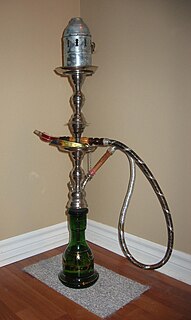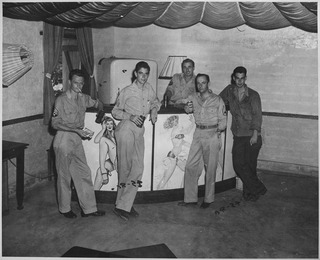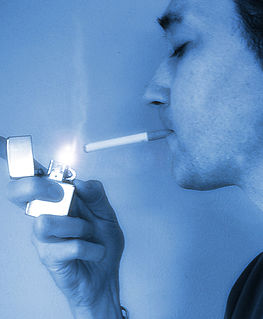
Tobacco smoking is the practice of burning tobacco and ingesting the smoke that is produced. The smoke may be inhaled, as is done with cigarettes, or simply released from the mouth, as is generally done with pipes and cigars. The practice is believed to have begun as early as 5000–3000 BC in Mesoamerica and South America. Tobacco was introduced to Eurasia in the late 17th century by European colonists, where it followed common trade routes. The practice encountered criticism from its first import into the Western world onwards but embedded itself in certain strata of a number of societies before becoming widespread upon the introduction of automated cigarette-rolling apparatus.
Tobacco harm reduction (THR) is a public health strategy to lower the health risks to individuals and wider society associated with using tobacco products. It is an example of the concept of harm reduction, a strategy for dealing with the use of drugs. Tobacco smoking is widely acknowledged as a leading cause of illness and death, and reducing smoking is vital to public health.

Smoking in Japan, though historically less restricted by law than in many other nations, has significantly changed in recent years. Tobacco use has been in nearly constant decline since 1996 and the decline has been mainly accelerating in recent years.

The Family Smoking Prevention and Tobacco Control Act, is a federal statute in the United States that was signed into law by President Barack Obama on June 22, 2009. The Act gives the Food and Drug Administration the power to regulate the tobacco industry. A signature element of the law imposes new warnings and labels on tobacco packaging and their advertisements, with the goal of discouraging minors and young adults from smoking. The Act also bans flavored cigarettes, places limits on the advertising of tobacco products to minors and requires tobacco companies to seek FDA approval for new tobacco products.

Inflight smoking refers to smoking tobacco on an aircraft while in flight. While once prevalent, it is now prohibited by almost all airlines and by many governments around the world. The bans on inflight smoking have been imposed in a piecemeal manner around the world beginning in the 1980s. The use of electronic cigarettes is also prohibited on many flights.

The use of tobacco products in Egypt is widespread. It is estimated that approximately twenty percent of the population uses tobacco products daily. Cigarettes are the most common form of tobacco consumption in Egypt, with an estimated twenty billion cigarettes smoked annually in the country. After cigarettes, shisha water-pipes are the most common form of tobacco consumption. Many Egyptians are not fully aware of the health risks of using a water-pipe and many believe it to be less harmful than cigarettes.

Smoking in the United States military has been observed in previous wars, but smoking's close association with the United States military started in World War I when tobacco companies began to target military personnel through the distribution of cigarettes to servicemen and the eventual inclusion of cigarettes into rations. Although the military has attempted to implement tobacco control initiatives, the association between smoking and military personnel has persisted to the present day as smoking rates remain high, despite declines in civilian rates. Such high rates have led to questions about the effect of smoking from the apparent health risks to troop readiness and training costs.

SmokinginCanada is banned in indoor public spaces, public transit facilities and workplaces, by all territories and provinces, and by the federal government. As of 2010, legislation banning smoking within each of these jurisdictions is mostly consistent, despite the separate development of legislation by each jurisdiction. Notable variations between the jurisdictions include: whether, and in what circumstances ventilated smoking rooms are permitted; whether, and up to what distance away from a building is smoking banned outside of a building; and, whether smoking is banned in private vehicles occupied by children.
Smoking in Ireland is banned fully in the general workplace, enclosed public places, restaurants, bars, education facilities, healthcare facilities and public transport. However, it is permitted in designated hotel rooms and there is no ban in residential care, prisons and in outdoor areas. Public opinion is in favour of the bans on smoking imposed in Ireland.

Under federal law the manufacture, importation, distribution, and advertisement of tobacco is regulated whilst the 16 federal states of Germany each have their own legislation regarding smoking in public places, which range from relatively weak regulations to full smoking bans in all licensed premises, childcare facilities, schools and governmental institutions. As of July 2016, nearly 40% of the German population live in a state which bans smoking in all restaurants, pubs, cafés and nightclubs. The other 13 states permit smoking in designated rooms or in bars with a floor area of less than 75 square meters.
Smoking in South Korea has decreased overall for both men and women in the past decades. However, a high prevalence of tobacco use is still observed, especially with the rise of novel tobacco products like e-cigarettes and heat-not-burn tobacco products. There are socioeconomic inequalities in smoking prevalence according to gender, income, education, and occupational class. Advocates call for measures to reduce the smoking rates and address smoking inequalities using a combination of monitoring and tobacco control policies. These measures include significant price hikes, mandatory warning photos on cigarette packs, advertising bans, financial incentives, medical help for quitting, and complete smoking bans in public places.
In the United Kingdom, smoking is legally permitted, with certain conditions set from laws enacted separately in England, Wales, Scotland and Northern Ireland. It is illegal to smoke tobacco in enclosed public places, such as restaurants, shops or pubs, under the Health Act 2006 for England and Wales, the Smoking Order 2006 for Northern Ireland and the Smoking, Health and Social Care (Scotland) Act 2005 for Scotland. It is also illegal to smoke in a car if one is transporting people under 18 or if a vehicle is being used for work purposes. Smoking is prevalent among a sizeable, but continuously reducing minority of the population. It has been argued that smoking puts considerable strain upon the NHS due to the health problems which can be directly linked with smoking. Successive UK Governments have endeavoured to reduce the prevalence of smoking. As part of this commitment, the NHS currently offers free help to smokers who want to quit.
Smoking in India has been known since at least 2000 BC when cannabis was smoked and is first mentioned in the Atharvaveda. Fumigation (dhupa) and fire offerings (homa) are prescribed in the Ayurveda for medical purposes and have been practiced for at least 3,000 years while smoking, dhumrapana (धूम्रपान), has been practiced for at least 2,000 years. Tobacco was introduced to India in the 17th century. It later merged with existing practices of smoking.

The Cigarettes and Other Tobacco Products Act, 2003 or COTPA, 2003 is an Act of Parliament of India enacted in 2003 to prohibit advertisement of, and to provide for the regulation of trade and commerce in, and production, supply and distribution of cigarettes and other tobacco products in India.

Tobacco-free college campuses are colleges and universities that have implemented policies prohibiting the use of tobacco products at all indoor and outdoor campus locations. Tobacco is known to be harmful to the health of smokers, bystanders, and the environment. Since this issue was first recognized, colleges have been creating policies for tobacco use on campus in an effort to improve health standards, provide more enjoyable campus conditions, and to reduce the negative environmental effects of tobacco.

Executive Order No. 26, entitled Providing for the Establishment of Smoke-Free Environments in Public and Enclosed Places, was issued by Philippine President Rodrigo Duterte on May 16, 2017. This executive order invoked the Clean Air Act of 1999 and the Tobacco Regulation Act of 2003 to impose a nationwide ban on smoking in all public places in the Philippines. The ban replicates on a national level an existing ordinance in Davao City that Duterte created as mayor in 2002. The order took effect on July 23, 2017, 60 days after its publication in a newspaper.

Tobacco policy in Armenia is the attempt by the Armenian authorities to regulate smoking in Armenia. Tobacco laws and regulations are controlled by the Ministry of Health of Armenia. Armenian men tend to be the most common tobacco users, as 42.5% of men over the age of 15 smoke.











